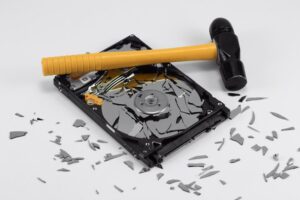What Your Noise-Cancelling Headphones Can and Can’t Do

It’s a frequent misconception that noise-canceling headphones are capable of fully blocking out all extraneous noise. People buy them to block out the noises of children playing, shouting employees, barking dogs next door, and aircraft engines. The difficulty is that with active noise cancellation, only one of the options is truly effective. (Spoiler alert: it’s the plane engine.) The reason for this has to do with the mechanics of sound and how noise-canceling headphones work.
The mechanics of active noise cancellation
Phase cancellation is a physics approach that is used in active noise reduction technologies. As you probably know, sound travels in waves, which move the air molecules. The waves travel through the air and into your ear canal, vibrating your eardrum. When a sound wave collides with another sound wave of the same frequency but opposite amplitude, the two sound waves cancel out.
Consider the air molecules to be a thread connecting two points. The string would be disrupted if someone pressed down on it squarely in the middle, causing a ripple.
The string would barely move if you pressed on one side of the string while someone else pressed on the opposite side of the string at the exact same location with the exact same force. Although this graphic may not exactly illustrate how sound waves work, it does show how a wave is effectively cancelled out when it is phase-matched with its opposite.
Using tiny microphones on the inside (and occasionally outside) of the earcups, active noise-canceling headphones analyse sound aimed at your ears and immediately play the opposite phase of that sound via the headphone drivers.
The competing forces successfully restrict air molecule mobility, resulting in a decrease in audible sound. This is a simplistic description, but it is the foundation upon which all modern ANC headphone designs are built.
In general, this type of active noise reduction works best at lower frequencies of sound, between 50 Hz and 1 kHz. This is partly because lower frequencies result in longer waves that are easier to coordinate. If the waves don’t line up properly, you’re more likely to hear feedback at higher frequencies. As a result, at 1 kHz, most active noise-canceling headphones lose a significant amount of their efficacy.
This is why ANC headphones are superior at reducing low, persistent sounds like motors and aircraft engines, but not for filtering out screaming children. (Researchers have told us that higher-frequency ANC concepts are in the works, but the technology is still a few years away.)
What kind of headphones should you invest in?
Regular fliers or those who want to filter out an annoying air conditioner hum might choose active noise-canceling headphones. But what if you want to block out human or dog barking noises? Passive isolation is used in this situation. Passive isolation is a physical barrier between your ears and the noises you don’t want to hear. The ear cups and ear cushions of many of the best—and most expensive—noise-canceling headphones are intended to block as much mid- and high-frequency noise as possible while remaining comfortable. As a result, in terms of noise reduction, you get the best of both worlds: both active and passive modes.
If you only want to filter out human voices and other higher-frequency noises, you do have more alternatives. You might be able to save money by using a pair of passive headphones. Almost all closed-back, over-ear headphones, particularly those designed for recording, are great for blocking out the sounds of children playing, employees chatting, and dogs barking.
I’ve also tested a number of noise-canceling headphones, and the Leaf Hush Anc Wireless Headphones are one of the best around Rs 5000. After 2.5 hours of charging, it has 25 hours of playtime in regular mode and 20 hours of playtime when noise cancelling is set on. It is lightweight and has a leather cushion and headband. Noise cancellation is a feature that may be switched on and off to improve your overall experience. The protein leather cushion’s soft shape makes it ideal for long-term use.
We’ve learned that the most reliable method of preventing higher-frequency sounds is to use earbuds that totally and deeply seal the ear canal. Many audiophile-style earphones with over-ear cable routing are made to fit deeper into your ear and efficiently block out higher-frequency sounds. Another alternative is to use noise-isolating foam tips with your existing headphones.
Aside from saving money, using passive noise-isolating headphones and earbuds prevents eardrum suck, an unpleasant sensation caused by active noise-canceling headphones. The sensation can range from moderate (as if your ears are about to explode) to intense (as if your ears are about to rupture like a full-on headache).
Some individuals don’t notice it, while others can ignore it or adapt to it. For others, though, it’s a deal-breaker that prohibits them from using ANC headphones.
Alternatives to noise-cancelling headphones
You have more choices if you’ve tried everything above and still can’t tune out the annoying noises. For example, white noise, rain, and wave noises are good in masking external noise. There are a number of programmes that may be used for this purpose. To protect your hearing, listen at a reasonable volume: experts say that listening at a maximum of 60% of your device’s volume for 60 minutes is usually safe. Then, before proceeding, take a little break from the noise.
Of course, earplugs are always accessible. If you’re easily distracted but still want music, consider the “nuclear option,” which entails wearing headphones and hearing-protection earmuffs at the same time. Keep in mind that true wireless earbuds won’t have controls, and corded earbuds will leave a cable wrinkle in your cheek if you do this. Is it a pleasurable experience for you? If the earbuds don’t protrude too much and the earmuffs have a deep enough ear cup, you can get used to it. But, believe me when I say this: it works. It’s conceivable that it’s the only product I’ve tested that truly muffles the sounds of a pint-sized rock band like the one in the commercial.
Author Bio – Vivek Roy is an enthusiastic Tech and gadget blogger from India. He loves to share tips and news from all around the world. For more information about him visit his website Leaf Studios.






